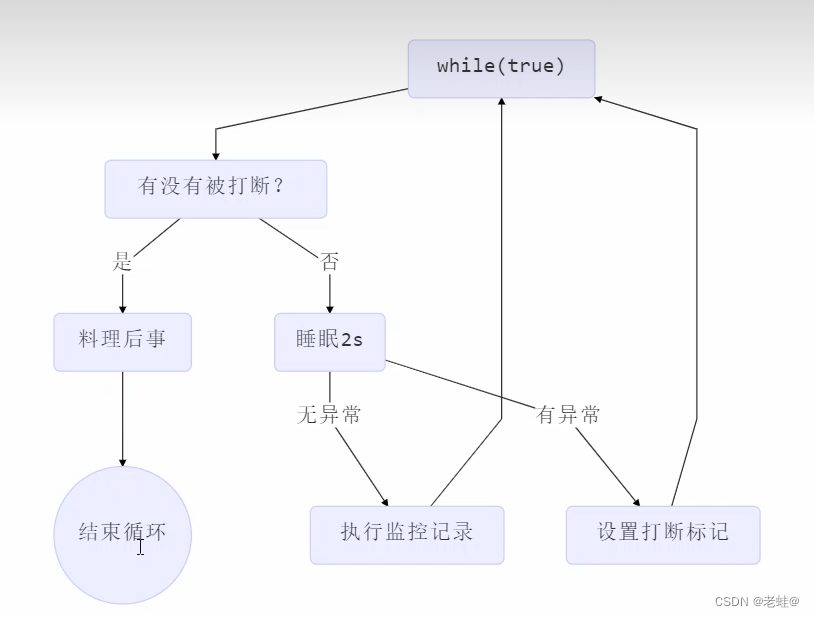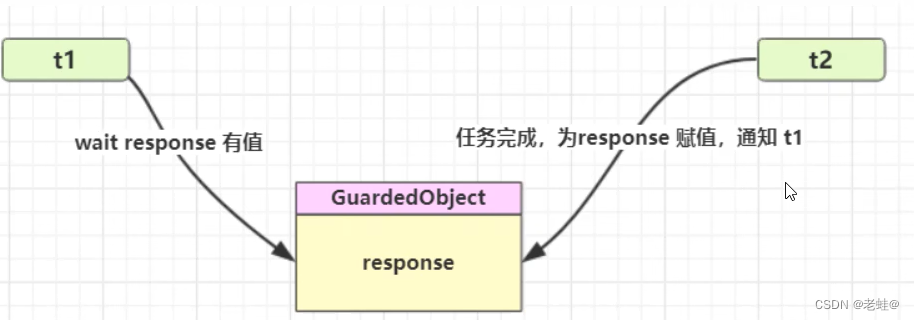两阶段终止
线程T1需要终止线程T2时,如果使用stop方法直接终止线程T2,T2申请的锁得不到释放;因此使用两阶段终止模式更加优雅
监控线程

@Slf4j
public class TwoPhaseTermination{
private Thread monitor;
private volatile boolean stop = false;
// 判断是否执行过start方法
private boolean starting = false;
public void start(){
synchronized(this){
if(starting){
return;
}
starting = true;
}
monitor = new Thread(()->{
while(true){
Thread current = Thread.currentThread();
if(stop){
log.debug("料理后事");
break;
}
try{
Thread.sleep(1000);
log.debug("执行监控记录");
} catch (InterruptedException e) {
e.printStackTrace();
}
}
});
monitor.start();
}
/**
* 停止监控线程
*/
public void stop(){
stop = true;
monitor.interrupt();
}
}
保护性暂停
保护性暂停用在一个线程等待另一个线程的执行结果时
要点:
- 有一个结果需要从一个线程传递到另一个线程,让他们关联同一个GuardedObject
- 如果有结果不断从一个线程到另一个线程,那么可以使用消息队列
- JDK中,join的实现、Future的实现采用的就是这个模式
- 因为要等待另一方的结果,所以归类到同步模式

class GuardedObject{
private Object response;
/**
* 获取结果
* @return
*/
public Object getResponse(long timeout) {
synchronized (this){
long begin = System.currentTimeMillis();
long passedTime = 0;
while(response==null){
if(passedTime>=timeout){
break;
}
try{
this.wait(timeout-passedTime);
}catch (InterruptedException e){
e.printStackTrace();
}
passedTime = System.currentTimeMillis()-begin;
}
return response;
}
}
/**
* 设置结果
* @param response
*/
public void complete(Object response){
synchronized (this){
this.response = response;
this.notifyAll();
}
}
}
join原理
public final synchronized void join(long millis)
throws InterruptedException {
// 刚开始进入等待的时间
long base = System.currentTimeMillis();
// 已经等待过的时间
long now = 0;
if (millis < 0) {
throw new IllegalArgumentException("timeout value is negative");
}
// 超时时间等于0,则一直等待
if (millis == 0) {
while (isAlive()) {
wait(0);
}
} else {
// 超时时间大于0
while (isAlive()) {
// 剩余的可以等待的时间
long delay = millis - now;
// 如果剩余的可以用的时间小于等于0,表示没法再等待了,直接退出
if (delay <= 0) {
break;
}
wait(delay);
now = System.currentTimeMillis() - base;
}
}
}
异步模式之生产者/消费者
- 与保护性暂停中的GuardObject不同,不需要产生结果和消费结果的线程一一对应
- 消费队列可以用来平衡生产和消费的线程资源
- 生产者仅负责产生结果数据,不关心数据该如何处理,而消费者专心处理结果数据
- 消息队列是有容量限制的,满时不会再加入数据,空时不会再消耗数据
- JDK中各种阻塞队列,采用的就是这种模式

/***
* 线程间通信队列
*/
class MessageQueue{
private LinkedList<Message> queue = new LinkedList<>();
private int capacity;
public MessageQueue(int capacity){
this.capacity = capacity;
}
public void put(Message message){
synchronized (queue){
while(queue.size()==capacity){
try {
queue.wait();
} catch (InterruptedException e) {
e.printStackTrace();
}
}
// 从尾部加入消息
queue.addLast(message);
queue.notifyAll();
}
}
public Message take(){
synchronized (queue){
while(queue.isEmpty()){
try {
queue.wait();
} catch (InterruptedException e) {
e.printStackTrace();
}
}
// 从头部取得消息
Message message = queue.removeFirst();
queue.notifyAll();
return message;
}
}
}
class Message{
private int id;
private Object value;
public Message(int id,Object value){
this.id = id;
this.value = value;
}
public int getId() {
return id;
}
public Object getValue() {
return value;
}
}
同步模式之顺序控制
固定运行顺序
必须现有两个线程,一个打印1,一个打印2;先要求先打印2再打印1
wait-notify
@Slf4j
public final class Demo{
private static boolean hasPrintTwo = false;
private static Object lock = new Object();
public static void main(String[] args) throws InterruptedException {
Object lock = new Object();
Thread printOne = new Thread(()->{
synchronized (lock){
while(!hasPrintTwo){
try {
lock.wait();
} catch (InterruptedException e) {
e.printStackTrace();
}
}
log.debug("{}",1);
}
},"t1");
Thread printTwo = new Thread(()->{
log.debug("{}",2);
hasPrintTwo = true;
synchronized (lock){
lock.notifyAll();
}
},"t2");
printOne.start();
Thread.sleep(1000);
printTwo.start();
}
}
park/unpark
@Slf4j
public final class Demo{
private static boolean hasPrintTwo = false;
public static void main(String[] args) throws InterruptedException {
Object lock = new Object();
Thread printOne = new Thread(()->{
while(!hasPrintTwo){
LockSupport.park();
}
log.debug("{}",1);
},"t1");
Thread printTwo = new Thread(()->{
log.debug("{}",2);
hasPrintTwo = true;
LockSupport.unpark(printOne);
},"t2");
printOne.start();
Thread.sleep(1000);
printTwo.start();
}
}
交替输出
三个线程交替输出a,b,c
wait/notify
@Slf4j
public final class Demo{
public static void main(String[] args) throws InterruptedException {
WaitNotify waitNotify = new WaitNotify(1,5);
Thread printA = new Thread(()->{
waitNotify.print("A",1,2);
},"t1");
Thread printB = new Thread(()->{
waitNotify.print("B",2,3);
},"t2");
Thread printC = new Thread(()->{
waitNotify.print("C",3,1);
},"t3");
printA.start();
printB.start();
printC.start();
}
}
class WaitNotify{
/**
* 等待标记,当等待标记和传入的标记一致才会退出等待
*/
private int flag;
/**
* 循环次数
*/
private int loopNumber;
public WaitNotify(int flag,int loopNumber){
this.flag = flag;
this.loopNumber = loopNumber;
}
/**
* 循环打印
* @param str
* @param waitFlag
* @param nextFlag
*/
public void print(String str,int waitFlag,int nextFlag){
for (int i = 0; i < loopNumber; i++) {
synchronized (this){
while(flag != waitFlag){
try {
this.wait();
} catch (InterruptedException e) {
e.printStackTrace();
}
}
System.out.println(str);
flag = nextFlag;
this.notifyAll();
}
}
}
}
await/signal
@Slf4j
public final class Demo{
public static void main(String[] args) throws InterruptedException {
AwaitSignal awaitSignal = new AwaitSignal(5);
Condition a = awaitSignal.newCondition();
Condition b = awaitSignal.newCondition();
Condition c = awaitSignal.newCondition();
Thread printA = new Thread(()->{
awaitSignal.print("A",a,b);
},"t1");
Thread printB = new Thread(()->{
awaitSignal.print("B",b,c);
},"t2");
Thread printC = new Thread(()->{
awaitSignal.print("C",c,a);
},"t3");
printA.start();
printB.start();
printC.start();
// 唤醒第一个线程,接下来的线程会被循环睡眠并唤醒
Thread.sleep(1000);
awaitSignal.lock();
try{
a.signal();
}finally {
awaitSignal.unlock();
}
}
}
class AwaitSignal extends ReentrantLock{
private int loopNumber;
public AwaitSignal(int loopNumber){
this.loopNumber = loopNumber;
}
public void print(String str,Condition current,Condition next){
for (int i = 0; i < loopNumber; i++) {
lock();
try {
// 将当前条件进入等待
current.await();
// 退出当前条件的等待
System.out.println(str);
// 唤醒下一条件
next.signal();
} catch (InterruptedException e) {
e.printStackTrace();
}finally {
unlock();
}
}
}
}
park/unpark
@Slf4j
public final class Demo{
static Thread printA;
static Thread printB;
static Thread printC;
public static void main(String[] args) throws InterruptedException {
ParkUnPark parkUnPark = new ParkUnPark(5);
printA = new Thread(()->{
parkUnPark.print("A",printB);
},"t1");
printB = new Thread(()->{
parkUnPark.print("B",printC);
},"t2");
printC = new Thread(()->{
parkUnPark.print("C",printA);
},"t3");
printA.start();
printB.start();
printC.start();
// 唤醒第一个线程,接下来的线程会被循环睡眠并唤醒
Thread.sleep(1000);
LockSupport.unpark(printA);
}
}
class ParkUnPark{
private int loopNumber;
public ParkUnPark(int loopNumber){
this.loopNumber = loopNumber;
}
public void print(String str,Thread next){
for (int i = 0; i < loopNumber; i++) {
LockSupport.park();
System.out.println(str);
LockSupport.unpark(next);
}
}
}






















 183
183











 被折叠的 条评论
为什么被折叠?
被折叠的 条评论
为什么被折叠?








